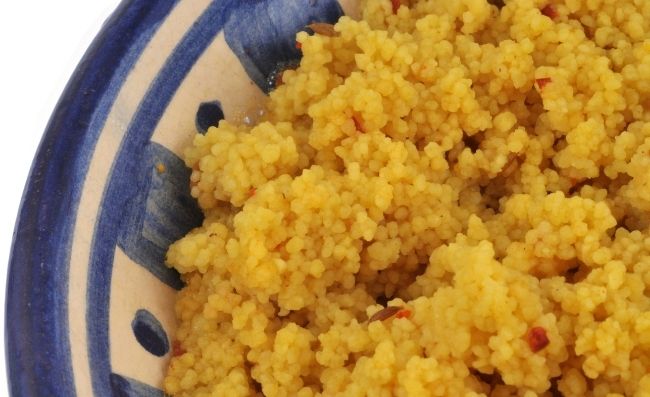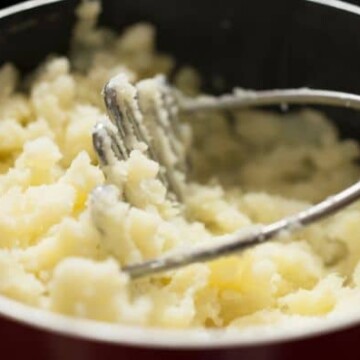The first thing that comes to my mind when I hear the word semolina is high gluten content. Semolina is made from durum wheat, a very hard species of wheat that is resistant to milling.
It has a very high gluten and protein content. Semolina is popular for making pasta thanks to its high gluten content. However, it is also used in several other dishes.
All-purpose flour is a type of white flour. A lot of people describe it as the perfect balance since it contains both soft wheat and hard wheat. It also contains a moderate amount of protein (about 12%). There are two main varieties of all-purpose flour in the market.

Bleached all-purpose flour and unbleached all-purpose flour. Personally, I prefer the unbleached one because it gives me the structure that I want in baked goods compared to the bleached one that does not retain the nuance of the wheat.
Now that you know what each one is what are the differences between the two?
Related Posts (Click to read)
- What is semolina made of?
- Suitable Semolina Substitutes
- What is a suitable polenta substitute?
- How long does frozen milk last after thawed?
Differences between Semolina and All-Purpose Flour

- What they are made from
Semolina is made from durum wheat whereas all-purpose flour is a combination of hard wheat and soft wheat.
- Gluten content
Semolina has a very high gluten content whereas all-purpose flour has a moderate gluten content.
- Nutrients
Semolina contains a good amount of protein, fiber, iron potassium, zinc, and phosphorus. All-purpose flow has a low protein content, potassium, and calcium.
- Uses
Semolina is ideal for use in pasta and other booked goods while all-purpose flour works perfectly in noodles and other baked goods.
- Flavor
Semolina has a sweet nutty flavor whereas all-purpose flour has a nutty flavor.
So which of the two is the best? Semolina is more nutritious compared to all-purpose flour. It has more protein compared to all-purpose flour and it also has more fiber in it. Semolina also contains other essential nutrients like iron, potassium, phosphorus, and zinc. Additionally, it contains B vitamins. The only advantage that all-purpose flour has over semolina is that it has fewer calories.
Semolina Uses

- Making pasta
Like I mentioned earlier, semolina is known for making pasta from scratch. Its high gluten content ensures that the dough is not too sticky. Semolina is also more elastic making it ideal for pasta.
- In bread
You can use semolina to make bread dough. Semolina will give your bread an amazing crumbly texture.
Check Out this Easy Semolina Bread Recipe
- In cookies
Semolina is ideal for cookies because it gives them that extra crunch.
- Thickening stews

If you want your stew to stop being thin, just add a little bit of semolina to it, the same way you add cornstarch. The stew will be thick in no time.
- Making porridge
You can use semolina to make porridge. Semolina porridge is very popular in India where it is either called sooji or rawa.
- Baking cakes
If you want to try something new, use semolina to bake your cakes. You will love the outcome. I have never gotten over how amazing my lemon cakes taste when I use semolina.
- On potatoes
If you are making fried or roasted potatoes, try sprinkling some semolina over the potatoes. The semolina will give your potatoes an extra crunch.
- Making pizza dough

You can use semolina to make pizza dough. The pizza dough will have the perfect texture and an amazing flavor.
- Making desserts
You can use semolina to make a tasty dessert pudding. Just add some semolina into boiling milk and then add some vanilla extract and honey. Stir it for a few minutes and remove it from heat when it thickens.
All-purpose flour uses
As the name suggests, all-purpose flour has several different uses. Here are a few.
- Baking bread

All-purpose flour is commonly used to make bread dough. Use it the same way you use any other type of flour.
- In cookies
- Making pizza dough
You can use all-purpose flour to make pizza dough.
- Making noodles
All-purpose flour may not be ideal for making pasta but you can use it to make noodles. Noodles turn out amazing when you use all-purpose flour.
- Baking cakes and muffins
You can use all-purpose flour to bake cakes and muffins. The only downside is that they won’t turn out as soft as they would have had you used cake flour
- Pancakes
I don’t make my pancakes using any other type of flour because all-purpose flour gives me the results that I want.
Advantages of using semolina instead of flour

- Can help you lose excess weight
Semolina has a high fiber and protein content. Therefore, if you eat food made using semolina, you will feel full for a long time and won’t need to eat soon after. You’ll lose weight in the long run.
- You won’t have digestion issues
The fiber in semolina plays a major role in ensuring that your digestive tract works the way it should.
If you have digestive tract issues like constipation, it is probably time to switch from all-purpose flour to semolina.
- Reduces the risk of heart disease

Research has shown that magnesium and folate in semolina promote heart health by protecting the heart and reducing the risk of heart disease.
- It has an amazing flavor
Who doesn’t love the sweet and nutty flavor of semolina? I know I do, so I choose to enjoy its amazing taste over the mild taste of all-purpose flour.
- Ideal in controlling the body’s cholesterol levels.
I use semolina because it ensures that my body does not develop high cholesterol levels.
Conclusion

Semolina and flour can be used interchangeably. In my opinion, semolina is better than flour.
It has more health benefits and it also tastes amazing. Semolina is more nutritious compared to all-purpose flour, so I suggest incorporating it into your diet.
You can use semolina in baked goods, pizza dough, potatoes, porridge, and also thickening stews. It will give your baked goods an amazing crumbly texture. You can also use it to make pasta if you feel motivated enough.




